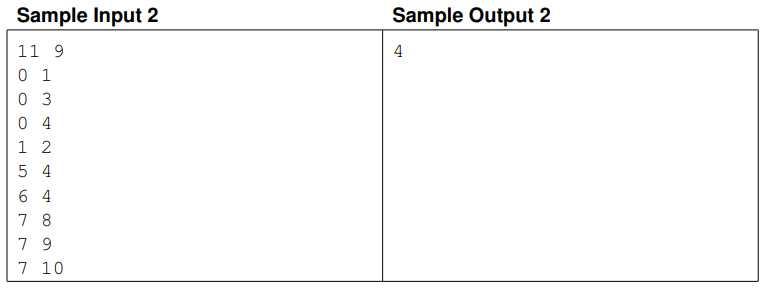标签:题目 lag build return namespace \n 连通 超时 编号
题意:
n个点,m条边,m <= n <= 100000,边的长度都为1。
点从 0 ~ n-1 编号。开始时图是不连通的,并且没有环。
通过加入一些边后,可以使图连通。要求加入的边不能多余(即生成的图是一棵树)。
问连通后的图,任意两点之间的距离的最大值,最小可以是多少?


既然刚开始图不连通也无环,那么就是一些树(特殊情况是点)。
于是题目就变成了,如何把很多棵树连起来,使最后生成的树直径最小。
可以想到,如果把两棵直径为 a 和 b 的树加一条边连成一棵,那么直径最小的新树直径为 (a+1)/2 + (b+1)/2 + 1 (两棵树的直径 / 2,向上取整,的和再加 1)
选择其中一个直径最大的子树,遍历所有其他的子树,然后将其他的子树加到这个子树上面。
求树的直径可以用DP。
这道题场上很快想出来了做法。然后一直T在 test 22。
原因是不会写树的直径DP求法,以及,memset超时。
每次找到新的联通块(新的一棵树)求树的直径就要memset一遍是不需要的。因为那些点肯定是不冲突的。
#include <cstdio> #include <cstring> #include <algorithm> #include <iostream> #include <queue> #include <cmath> #include <stack> #include <set> #include <map> using namespace std; const int maxn = 200000 + 1000; int fa[maxn], dis[maxn], tot = 0, v[maxn]; bool vis[maxn]; struct Node { int v, next, last, z; }a[maxn]; void build(int x, int y) { tot++; a[tot].v = y; a[tot].next = a[x].last; a[x].last = tot; } void dp(int x, int &ans) { v[x] = 1; for (int tmp = a[x].last; tmp; tmp = a[tmp].next) { int y = a[tmp].v; if (v[y]) continue; dp(y, ans); ans = max(ans, dis[x] + dis[y] + 1); dis[x] = max(dis[x], dis[y] + 1); } } void DFS(int x) { vis[x] = true; for (int tmp = a[x].last; tmp; tmp = a[tmp].next) { int y = a[tmp].v; if (!vis[y]) DFS(y); } } int main() { int n, m; scanf("%d%d", &n, &m); int x, y; for (int i = 1; i <= m; i++) { scanf("%d%d", &x, &y); build(x, y); build(y, x); } memset(vis, false, sizeof(vis)); memset(v, 0, sizeof(v)); memset(dis, 0, sizeof(dis)); int q[maxn], tt = 0; for (int i = 0; i < n; i++) if (!vis[i]) { int t = 0; dp(i, t); q[++tt] = t; DFS(i); } int ans = 0, flag = 0; for (int i = 1; i <= tt; i++) if (q[i] > ans) { ans = q[i]; flag = i; } for (int i = 1; i <= tt; i++) if (i != flag) ans = max(ans, (q[i]+1)/2+(ans+1)/2 + 1); printf("%d\n", ans); return 0; }
Gym - 100781A Adjoin the Networks (树的直径)
标签:题目 lag build return namespace \n 连通 超时 编号
原文地址:https://www.cnblogs.com/ruthank/p/9379848.html